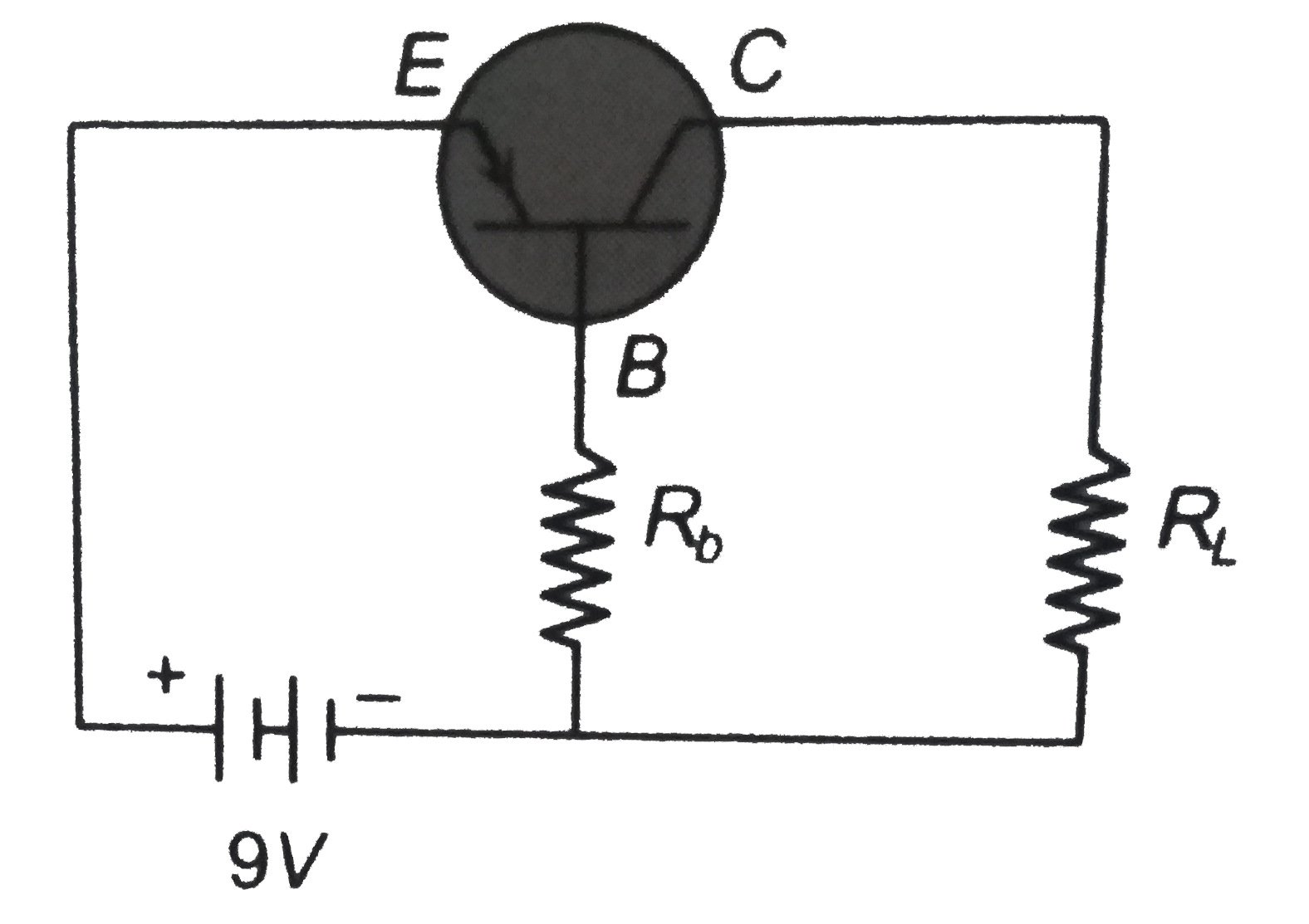In a common emitter transistor circuit, the base current is 40μA , then VBE is
2V
0.2V
0.8V
Zero
The correct Answer is:B
To find the base-emitter voltage VBE in a common emitter transistor circuit, we can follow these steps:
1. Identify Given Values:
- Base current IB=40μA=40×10−6A
- Resistor connected to the base RB=245kΩ=245×103Ω
- Supply voltage VCC=10V
2. Use Kirchhoff’s Voltage Law:
According to Kirchhoff's Voltage Law, we can write the equation for the loop involving VCC, the voltage drop across RB, and VBE:
VCC−IB⋅RB−VBE=0
3. Rearranging the Equation:
Rearranging the equation to solve for VBE:
VBE=VCC−IB⋅RB
4. Substituting the Values:
Substitute the known values into the equation:
VBE=10V−(40×10−6A)⋅(245×103Ω)
5. Calculating the Voltage Drop Across RB:
Calculate IB⋅RB:
IB⋅RB=40×10−6⋅245×103=9.8V
6. Final Calculation of VBE:
Now substitute back into the equation for VBE:
VBE=10V−9.8V=0.2V
7. Conclusion:
Therefore, the value of VBE is 0.2V.
Final Answer:
VBE=0.2V
- Base current IB=40μA=40×10−6A
- Resistor connected to the base RB=245kΩ=245×103Ω
- Supply voltage VCC=10V
According to Kirchhoff's Voltage Law, we can write the equation for the loop involving VCC, the voltage drop across RB, and VBE:
VCC−IB⋅RB−VBE=0
Rearranging the equation to solve for VBE:
VBE=VCC−IB⋅RB
Substitute the known values into the equation:
VBE=10V−(40×10−6A)⋅(245×103Ω)
Calculate IB⋅RB:
IB⋅RB=40×10−6⋅245×103=9.8V
Now substitute back into the equation for VBE:
VBE=10V−9.8V=0.2V
Therefore, the value of VBE is 0.2V.
VBE=0.2V
Topper's Solved these Questions
- SEMICONDUCTOR ELECTRONICS (MATERIAL, DEVICES AND SIMPLE CIRUITS )Book:AAKASH INSTITUTE ENGLISHChapter:SEMICONDUCTOR ELECTRONICS (MATERIAL, DEVICES AND SIMPLE CIRUITS )Exercise:Assignment section -B (Objective Type Question)
Explore 29 Videos
- SEMICONDUCTOR ELECTRONICS (MATERIAL, DEVICES AND SIMPLE CIRUITS )Book:AAKASH INSTITUTE ENGLISHChapter:SEMICONDUCTOR ELECTRONICS (MATERIAL, DEVICES AND SIMPLE CIRUITS )Exercise:Assignment section -C (Previous years type question)
Explore 110 Videos
- SEMICONDUCTOR ELECTRONICS (MATERIAL, DEVICES AND SIMPLE CIRUITS )Book:AAKASH INSTITUTE ENGLISHChapter:SEMICONDUCTOR ELECTRONICS (MATERIAL, DEVICES AND SIMPLE CIRUITS )Exercise:EXERCISE
Explore 20 Videos
- RAY OPTICS AND OPTICAL INSTRUMENTSBook:AAKASH INSTITUTE ENGLISHChapter:RAY OPTICS AND OPTICAL INSTRUMENTSExercise:ASSIGNMENT (SECTION - D)
Explore 16 Videos
- SEMICONDUCTOR ELECTRONICS: MATERIALS, DEVICES AND SIMPLE CIRCUITSBook:AAKASH INSTITUTE ENGLISHChapter:SEMICONDUCTOR ELECTRONICS: MATERIALS, DEVICES AND SIMPLE CIRCUITSExercise:Assignment (Section-D (Assertion and reason))
Explore 5 Videos
Similar Questions
Knowledge Check
In a common -emitter transistor amplifier, an increase of 50μA in the base current causes an increase of 1.0mA in the collector current . Calculat gain β. What will be the change in emitter current? Also calculate current gain α
A1050 mAB1050 μAC5025 mAD5025 μA
In a common base transistor circuit, the current gain is 0.98. On changing the emitter current by 5.00 mA, the change in collector current is
View SolutionIn a common emitter transistor, the current gain is 80. What is the change in collector current, when the change in base current is 250μA?
View Solution
(a) For given transistor circuit, the base current is 10μA and the collector current is 5.2 mA. Can this transistor circuit be used as an amplifier. Your answer must be supported with proper explanation.
(b). For a common emitter amplifier, current gain is 69. if the emitter current is 7 mA then calculate the base current and collector current.
View SolutionThe frequency of oscillation of current in the indcutor is

View SolutionIn a transistor circuit shown here the base current is 35μA. The value of the resistor Rb is

View SolutionIn a common emitter configuration base current is 40μA and current gian is 100. The collector current will be
View SolutionIn a common base transistor circuit, IC is the Output current and IE is the input current. The current gain α is
View Solution
_E01_409_Q01.png)